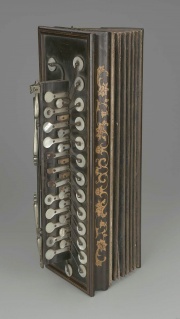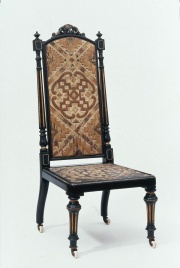Difference between revisions of "Ebonizing"
Jump to navigation
Jump to search
m (Text replace - "== Authority ==" to "== Sources Checked for Data in Record ==") |
|||
| Line 1: | Line 1: | ||
| − | [[File:17.1946-SC34123.jpg|thumb|]] | + | [[File:17.1946-SC34123.jpg|thumb|Accordion<br>MFA# 17.1946]] |
== Description == | == Description == | ||
| − | + | [[File:1992.521-SL10843.jpg|thumb|Ebonized mahogany chair<br>MFA# 1992.521]] | |
A black wood stain design to imitate the appearance of [[ebony]]. This wood finish was popular during the 19th century for interior millwork, pianos, clocks, and furniture. One ebonizing method used [[black shellac]] while another used ferrotannin complexes. | A black wood stain design to imitate the appearance of [[ebony]]. This wood finish was popular during the 19th century for interior millwork, pianos, clocks, and furniture. One ebonizing method used [[black shellac]] while another used ferrotannin complexes. | ||
| Line 8: | Line 8: | ||
ebonize; black shellac | ebonize; black shellac | ||
| − | == | + | ==Resources and Citations== |
| − | |||
| − | |||
| − | |||
| − | |||
| − | |||
| − | |||
| − | |||
* ''Dictionary of Building Preservation'', Ward Bucher, ed., John Wiley & Sons, Inc., New York City, 1996 | * ''Dictionary of Building Preservation'', Ward Bucher, ed., John Wiley & Sons, Inc., New York City, 1996 | ||
Latest revision as of 12:42, 1 August 2022
Description
A black wood stain design to imitate the appearance of Ebony. This wood finish was popular during the 19th century for interior millwork, pianos, clocks, and furniture. One ebonizing method used Black shellac while another used ferrotannin complexes.
Synonyms and Related Terms
ebonize; black shellac
Resources and Citations
- Dictionary of Building Preservation, Ward Bucher, ed., John Wiley & Sons, Inc., New York City, 1996

